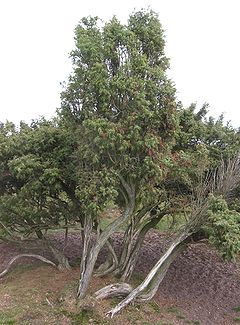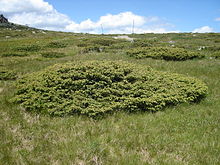- Juniperus communis
-
Juniperus communis 
Juniperus communis subsp. communis
in the NetherlandsConservation status Scientific classification Kingdom: Plantae Division: Pinophyta Class: Pinopsida Order: Pinales Family: Cupressaceae Genus: Juniperus Species: J. communis Binomial name Juniperus communis
L.Juniperus communis, the Common Juniper, is a species in the genus Juniperus, in the family Cupressaceae. It has the largest range of any woody plant, throughout the cool temperate Northern Hemisphere from the Arctic south in mountains to around 30°N latitude in North America, Europe and Asia.
Contents
Description
Juniperus communis is a shrub or small tree, very variable and often a low spreading shrub, but occasionally reaching 10 m tall. Common Juniper has needle-like leaves in whorls of three; the leaves are green, with a single white stomatal band on the inner surface. It is dioecious, with male and female cones on separate plants, which are wind pollinated.
The seed cones are berry-like, green ripening in 18 months to purple-black with a blue waxy coating; they are spherical, 4–12 mm diameter, and usually have three (occasionally six) fused scales, each scale with a single seed. The seeds are dispersed when birds eat the cones, digesting the fleshy scales and passing the hard seeds in their droppings. The male cones are yellow, 2–3 mm long, and fall soon after shedding their pollen in March–April.[2][3][4]
Subspecies
As to be expected from the wide range, Juniperus communis is very variable, with several infraspecific taxa; delimitation between the taxa is still uncertain, with genetic data not matching morphological data well.[2][3][4][5][6][7][8][9]
- Juniperus communis subsp. communis – Common Juniper. Usually an erect shrub or small tree; leaves long, 8–20(–27) mm; cones small, 5–8 mm, usually shorter than the leaves; found at low to moderate altitude in temperate climates.
- Juniperus communis subsp. communis var. communis – Europe, most of northern Asia
- Juniperus communis subsp. communis var. depressa Pursh – North America, Sierra Nevada in California
- Juniperus communis subsp. communis var. hemisphaerica (J.Presl & C.Presl) Parl. – Mediterranean mountains
- Juniperus communis subsp. communis var. nipponica (Maxim.) E.H.Wilson – Japan (status uncertain, often treated as J. rigida var. nipponica)
- Juniperus communis subsp. alpina (Suter) Čelak. – Alpine Juniper (syn. J. c. subsp. nana, J. c. var. saxatilis Pallas, J. sibirica Burgsd.). Usually a prostrate ground-hugging shrub; leaves short, 3–8 mm; cones often larger, 7–12 mm, usually longer than the leaves; found in subarctic areas and high altitude alpine zones in temperate areas.
- Juniperus communis subsp. alpina var. alpina – Greenland, Europe and Asia
- Juniperus communis subsp. alpina var. megistocarpa Fernald & H.St.John – Eastern Canada (doubtfully distinct from var. alpina)
- Juniperus communis subsp. alpina var. jackii Rehder – Western North America (doubtfully distinct from var. alpina)
Some botanists treat subsp. alpina at the lower rank of variety, in which case the correct name is Juniperus communis var. saxatilis Pallas,[3] though the name Juniperus communis var. montana is also occasionally cited; others, primarily in eastern Europe and Russia, sometimes treat it as a distinct species J. sibirica Burgsd. (syn. J. nana Willd., J. alpina S.F.Gray).[10]
Juniperus communis is one of Ireland's longest established plants.[11]
Uses
Cultivation
Juniperus communis is cultivated in the horticulture trade and used as an evergreen ornamental shrub in gardens.
Crafts
It is too small to have any general lumber usage. In Scandinavia, however, juniper wood is used for making containers for storing small quantities of dairy products such as butter and cheese, and also for making wooden butter knives. In Estonia juniper wood is valued for its long lasting and pleasant aroma, very decorative natural structure of wood (growth rings) as well as good physical properties of wood due to slow growth rate of juniper and resulting dense and strong wood. Various decorative items (often eating utensils) are common in most Estonian handicraft shops and households.
According to the old tradition, on Easter Monday Kashubian (Northern Poland) boys chase girls whipping gently their legs with juniper twigs. This is to bring good fortune in love to the chased girls.
Culinary
Its astringent blue-black seed cones, commonly known as "Juniper berries", are too bitter to eat raw and are usually sold dried and used to flavour meats, sauces, and stuffings. They are generally crushed before use to release their flavour. The cones are used to flavour gin. In fact, the word 'gin' is derived from the French word for juniper berry, genièvre, which is the name for gin in France. The Slovak national alcoholic beverage Borovička is also flavoured with juniper berry extract.
Since juniper berries have a strong taste, they should be used sparingly. They are generally used to enhance meat with a strong flavour, such as game, including game birds, or tongue. In Finland, juniper is used as a key ingredient in making sahti, a traditional Finnish ale.
Dioscorides' De materia medica also lists juniper berries, when crushed and put on the penis or vagina before intercourse, as a contraceptive.[12]
Medicinal
Juniper berries have long been used as medicine by many cultures. Juniper berries act as a strong urinary tract disinfectant if consumed and were used by Native Americans as a herbal remedy for urinary tract infections. Western American tribes combined the berries of juniperus communis with Berberis root bark in a herbal tea to treat diabetes.
Clinical studies have verified the traditional use of this treatment in insulin-dependent diabetes.[citation needed] Compounds in these plants when combined and ingested have been shown to trigger insulin production in the body's fat cells, as well as stabilize blood sugar levels. Native Americans also used juniper berries as a female contraceptive.[13]
References
- ^ Conifer Specialist Group 1998. Juniperus communis. In: IUCN 2009. IUCN Red List of Threatened Species. Version 2009.2. <www.iucnredlist.org>. Downloaded on 03 March 2010.
- ^ a b Rushforth, K. (1987). Conifers. Helm ISBN 0-7470-2801-X.
- ^ a b c Adams, R. P. (2004). Junipers of the World: The genus Juniperus. Victoria: Trafford. ISBN 1-4120-4250-X.
- ^ a b Arboretum de Villardebelle: Juniperus
- ^ Flora Europaea: Juniperus communis
- ^ Adams, R. P., Pandey, R. N., Leverenz, J. W., Dignard, N., Hoegh, K., & Thorfinnsson, T. (2003). Pan-Arctic variation in Juniperus communis: Historical Biogeography based on DNA fingerprinting. Biochem. Syst. Ecol. 31: 181-192 pdf file.
- ^ Adams, R. P., & Pandey, R. N. (2003). Analysis of Juniperus communis and its varieties based on DNA fingerprinting. Biochem. Syst. Ecol. 31: 1271-1278. pdf file
- ^ Adams, R. P., & Nguyen, S. (2007). Post-Pleistocene geographic variation in Juniperus communis in North America. Phytologia 89 (1): 43-57. pdf file
- ^ Den Virtuella Floran: Juniperus communis distribution
- ^ Association Ecosystem (Russia): Juniperus sibirica
- ^ Preston, S. J.; Wilson, C.; Jennings, S.; Provan, J.; McDonald, R. A. (2007). "The status of Juniperus communis L. in Northern Ireland in 2005". Ir. Nat. J. 28: 372–378.
- ^ Riddle, J. M. (1992). Contraception and abortion from the ancient world to the Renaissance, p. 31. Harvard University Press.
- ^ Edible and Medicinal Plants of the West, Gregory L. Tilford, ISBN 0-87842-359-1
- Conifer Specialist Group (1998). Juniperus communis. 2006. IUCN Red List of Threatened Species. IUCN 2006. www.iucnredlist.org. Retrieved on 12 May 2006. Database entry includes a brief justification of why this species is of least concern
External links
Categories:- IUCN Red List least concern species
- Juniperus
- Arctic flora
- Alpine flora
- Flora of North America
- Flora of Europe
- Flora of Northeast Asia
- Trees of the United States
- Trees of Alabama
- Trees of California
- Trees of Michigan
- Trees of Siberia
- Flora of Ontario
- Flora of Oregon
- Flora of Finland
- Flora of Estonia
- Flora of the Sierra Nevada region (U.S.)
- Flora of Alaska
- Flora of Russia
- Flora of the Faroe Islands
- Edible plants
- Medicinal plants
- Traditional Native American medical plants
- Ornamental trees
- Garden plants of North America
- Garden plants of Europe
- Least concern plants
- Trees of Ontario
- Juniperus communis subsp. communis – Common Juniper. Usually an erect shrub or small tree; leaves long, 8–20(–27) mm; cones small, 5–8 mm, usually shorter than the leaves; found at low to moderate altitude in temperate climates.
Wikimedia Foundation. 2010.






